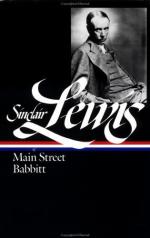The authors whom she read were most of them frightfully annoyed by the Vida Sherwins. They were young American sociologists, young English realists, Russian horrorists; Anatole France, Rolland, Nexo, Wells, Shaw, Key, Edgar Lee Masters, Theodore Dreiser, Sherwood Anderson, Henry Mencken, and all the other subversive philosophers and artists whom women were consulting everywhere, in batik-curtained studios in New York, in Kansas farmhouses, San Francisco drawing-rooms, Alabama schools for negroes. From them she got the same confused desire which the million other women felt; the same determination to be class-conscious without discovering the class of which she was to be conscious.
Certainly her reading precipitated her observations of Main Street, of Gopher Prairie and of the several adjacent Gopher Prairies which she had seen on drives with Kennicott. In her fluid thought certain convictions appeared, jaggedly, a fragment of an impression at a time, while she was going to sleep, or manicuring her nails, or waiting for Kennicott.
These convictions she presented to Vida Sherwin—Vida Wutherspoon—beside a radiator, over a bowl of not very good walnuts and pecans from Uncle Whittier’s grocery, on an evening when both Kennicott and Raymie had gone out of town with the other officers of the Ancient and Affiliated Order of Spartans, to inaugurate a new chapter at Wakamin. Vida had come to the house for the night. She helped in putting Hugh to bed, sputtering the while about his soft skin. Then they talked till midnight.
What Carol said that evening, what she was passionately thinking, was also emerging in the minds of women in ten thousand Gopher Prairies. Her formulations were not pat solutions but visions of a tragic futility. She did not utter them so compactly that they can be given in her words; they were roughened with “Well, you see” and “if you get what I mean” and “I don’t know that I’m making myself clear.” But they were definite enough, and indignant enough.
III
In reading popular stories and seeing plays, asserted Carol, she had found only two traditions of the American small town. The first tradition, repeated in scores of magazines every month, is that the American village remains the one sure abode of friendship, honesty, and clean sweet marriageable girls. Therefore all men who succeed in painting in Paris or in finance in New York at last become weary of smart women, return to their native towns, assert that cities are vicious, marry their childhood sweethearts and, presumably, joyously abide in those towns until death.
The other tradition is that the significant features of all villages are whiskers, iron dogs upon lawns, gold bricks, checkers, jars of gilded cat-tails, and shrewd comic old men who are known as “hicks” and who ejaculate “Waal I swan.” This altogether admirable tradition rules the vaudeville stage, facetious illustrators, and syndicated newspaper humor, but out of actual life it passed forty years ago. Carol’s small town thinks not in hoss-swapping but in cheap motor cars, telephones, ready-made clothes, silos, alfalfa, kodaks, phonographs, leather-upholstered Morris chairs, bridge-prizes, oil-stocks, motion-pictures, land-deals, unread sets of Mark Twain, and a chaste version of national politics.




